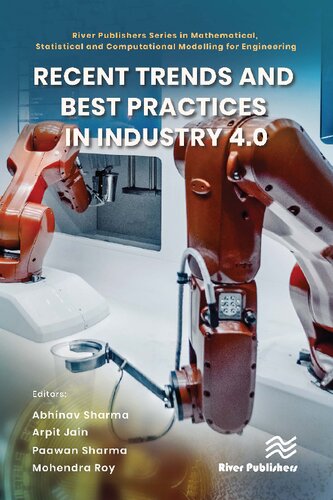Recent Trends and Best Practices in Industry 4.0 1st Edition by Abhinav Sharma, Arpit Jain, Paawan Sharma, Mohendra Roy 8770228051 9788770228053
$50.00 Original price was: $50.00.$25.00Current price is: $25.00.
Recent Trends and Best Practices in Industry 4.0 1st Edition by Abhinav Sharma, Arpit Jain, Paawan Sharma, Mohendra Roy – Ebook PDF Instant Download/Delivery: 8770228051, 9788770228053
Full download Recent Trends and Best Practices in Industry 4.0 1st Edition after payment

Product details:
ISBN 10: 8770228051
ISBN 13: 9788770228053
Author: Abhinav Sharma, Arpit Jain, Paawan Sharma, Mohendra Roy
Industry 4.0 is used interchangeably with the fourth industrial revolution and represents a new stage in the organization asnd control of the industrial value chain. Cyber-physical systems form the basis of industry 4.0 (e.g., ‘smart machines’). They use modern control systems, have embedded software systems, can be addressed via IoT (the Internet of Things), and may use extensive data analytics and/or articifical inteligence systems to operate autonomously. The aim of this book is to provide detailed insights into the state of art techniques in AI, IoT, Blockchain technology and associated technologies which play a vital role in the implementation of a successful project for upcoming and practicing engineers. Owing to its multidisciplinary nature, Industry 4.0 is not a single topic but a combination of a multitude of technologies from different domains. Keeping this in mind the book includes the following topics: Artificial intelligence Internet of things Blockchain technology Digital manufacturing Robotics Cybersecurity The book will be a comprehensive guide to academicians and engineers who want to align with recent trends of fourth industrial revolution.
Recent Trends and Best Practices in Industry 4.0 1st Table of contents:
1 Artificial Intelligence in the Digital Chemical Industry, its Application and Sustainability
1.1 Introduction
1.2 AI in the Chemical Industry and Applications
1.2.1 AI in chemical science
1.2.2 AI in research and development
1.2.3 AI in catalyst design spaces
1.3 Sustainability of AI Applications
1.3.1 Environmental aspect
1.3.2 Energy aspect
1.3.3 Economic aspect
1.3.4 Time aspect
1.3.5 Safety and human factor aspect
1.4 Digital Transformation of the Chemical Industry
1.4.1 State of digital transformation
1.4.2 Key trends in digitalization
1.4.3 Optimizing production
1.4.4 Supporting remote operations
1.4.5 Reducing waste
1.4.6 Unlocking new growth opportunities
1.4.7 Increasing supply chain visibility
1.4.8 Safety, compliance, and sustainability
1.5 Digital Chemical Industry 4.0
1.6 Challenges of AI in the Chemical Industry
1.7 Industry 4.0 Impact Technologies
1.8 Conclusion
References
2 Managing the Transition Toward Industry 4.0: A Study on the Implementation of Digital Manufacturing Processes
2.1 Introduction
2.2 Main Text
2.2.1 Problem formulation
2.2.2 Purpose and question
2.2.3 Related research
2.2.4 Industry 4.0
2.2.5 Strategic guidance for IIoT
2.2.6 Strategy
2.2.7 Resources and competencies
2.2.8 IT maturity
2.2.9 Smart manufacturing
2.2.10 Method
2.2.11 Delimitation
2.2.12 Method selection
2.2.13 Data collection
2.2.14 Literature review
2.2.15 Interview
2.2.16 Selection and respondents
2.2.17 Ethics
2.2.18 Data analysis
2.2.19 Transcription
2.2.20 Coding
2.2.21 Method discussion
2.3 Outcomes of the Study
2.3.1 Industry 4.0
2.3.2 Strategy
2.3.3. Resources and competencies
2.3.4. IT maturity
2.3.5 Smart manufacturing
2.4 Conclusion
References
3 Container as a Service in the Cloud: An Approach to Secure Hybrid Virtualization
3.1 Introduction
3.2 Virtualization in Cloud Computing
3.2.1 System level virtualization
3.2.2 OS level virtualization
3.2.3 Container vs. virtual machine
3.2.4 Architectural difference between VM and container
3.3 Container as a Service Model
3.3.1 CaaS architecture
3.4 Containerization Techniques
3.4.1 Docker
3.4.2 Singularity
3.4.3 uDocker
3.5 Research Challenges
3.6 Conclusion
References
4 Automated Framework for Detecting Unknown Activity in a Vehicular ad hoc Network
4.1 Introduction
4.1.1 VANET deployment challenges
4.1.2 VANET applications
4.1.3 Possible attacks on vehicular network
4.1.4 ML for vehicular networking
4.1.5 Current challenges and opportunities
4.1.6 Research gap
4.1.7 Problem statement
4.1.8 Motivation
4.2 Literature Work
4.2.1. An overview
4.2.2 Mobility-based routing in VANET with security
4.2.3 Encryption and authentication
4.3 Proposed Approach
4.3.1 Methodology
4.3.2 Improve hybrid cooperative malicious node detection approach (IHCMNDA)
4.4 Result and Discussion
4.4.1 Simulation
4.4.2 Improved cooperative bait detection (ICBDS)
4.4.3 Improve hybrid cooperative malicious node detection approach (IHCMNDA)
4.5 Conclusion and Future Work
References
5 Control of Mobile Manipulator with Object Detection for EOD Applications
5.1 Introduction
5.1.1 Explosive ordnance disposal robots
5.2 Object Detection
5.2.1 Computer-aided design of the proposed design
5.2.2 System architecture
5.3 Hardware Architecture
5.3.1 Robot-arm contol and actuation
5.4 Object Detection
5.4.1 TensorFlow
5.4.2 TensorFlow object detection API
5.5 Results and Discussion
5.5.1 Hardware implementation
5.5.2 Robotic arm simulation using MATLAB GUI
5.5.3 Simulation in gazebo using ROS
5.6 Conclusion
Acknowledgments
References
6 Smart Agriculture: Emerging and Future Farming Technologies
6.1 Introduction
6.2 Role of Smart Agriculture in Yield Enhancement
6.2.1 Soil samples and its mapping
6.2.2 Smart irrigation systems
6.2.3 Smart fertilizer system
6.2.4 Smart disease control and pest management
6.2.5 Smart monitoring of crop yields and climatic conditions
6.3 Technologies Involved in Precision Agriculture
6.3.1 Wireless sensing technology in agriculture
6.3.2 Communication methods and latest technologies in smart agriculture
6.3.3 Latest technologies for large data processing
6.4 Autonomous Vehicles in Smart Agriculture
6.4.1 IoT-based tractors
6.4.2 Harvesting robots
6.4.3 UAVs in agriculture
6.5 Challenges in Smart Agriculture
6.6 Conclusions and Future Directions
References
7 Plant Feature Extraction for Disease Classification
7.1 Introduction
7.2 Literature Review
7.3 Features Representation and Characteristics
7.4 Texture Features
7.4.1 Statistical methods for texture classification
7.4.2 Gray-level run-length matrix
7.4.3 Advantages and limitations
7.4.4 Histogram of gradient magnitudes
7.5 Color Features Extraction
7.5.1 Advantage and disadvantages
7.5.2 Color co-occurrence matrix (CCM)
7.6 Shape-based Feature Extraction
a. Distances (Object length)
b Center of gravity
c Area (A):
d Hole:
e Perimeter (p):
f. Major-axis Angle
g. Roundness
h Euler number
i Eccentricity
j Boundary rectangle area
7.6.1 Advantage and disadvantages
7.7 Conclusion and Future Scope
References
8 Development Methodologies for the Internet of Things: For all Commercial and Industrial Needs
8.1 Introduction
8.2 Research Questions
8.3 Development Methodologies
8.3.1 Development methodologies for IoT-based smart cities
8.3.2 Development methodologies for IoT-based automatic driving
8.3.3 Development methodologies for IoT-based agriculture field monitoring
8.3.4 Development methodologies for IoT-based railway monitoring
8.3.5 Development methodologies for IoT-based forest monitoring
8.4 Conclusion
References
9 Bio-inspired Multilevel ICHB-HEED Clustering Protocol for Heterogeneous WSNs
9.1 Introduction
9.2 Review of Literature
9.3 Proposed Work
9.3.1 Network model for multilevel energy heterogeneity
9.3.2 MLICHBHEED protocol
9.4 Results and Discussions
9.4.1 Network lifetime
9.4.2 Total energy consumption
9.4.3 Number of packets sent to the base station
9.5 Conclusion
References
10 IoT Enabled by Edge Computing for Telecomms and Industry
10.1 Introduction to IoT and Edge Computing
10.1.1 IoT and edge-computing scenarios
10.1.2 IoT versus edge computing
10.1.3 Industry 4.0
10.1.4 Cloud computing and edge computing
10.1.5 Cloud computing and edge computing: use cases
10.2 IoT and Edge Computing Framework
10.2.1 IoT and edge computing integrated framework
10.2.2 Pros and cons
10.2.3 Opportunities and challenges
10.3 Edge Computing Devices
10.4 Telcos and Edge Computing
10.4.1 Telco network modernizations challenges
10.4.2 Multi-access edge computing [16], [17]
10.5 Task Scheduling in Edge Computing
10.5.1 Scheduler-based edge computing
10.5.2 Computing task analysis
10.5.3 Computing task scheduling scheme
10.6 Security and Privacy Issues of Edge Computing
10.6.1 Attacks classification
10.7 Conclusion
References
11 Low-energy Network Protocols
11.1 Introduction
11.2 IIoT
11.2.1 Network architecture
11.2.2 Protocols
11.2.3 Testbed
11.2.4 Criteria for implementation
11.3 Low-energy Technologies
11.4 Self-powered Network
11.4.1 Comparison between energy harvesting WSNs and battery-operated WSNs
11.4.2 Energy-harvesting sources for sensors
11.4.3 Energy stored by a supercapacitor
11.4.4 Proposed circuit
11.4.5 BLE–RSL10 from ON Semiconductor
11.4.6 Key features of BLE-RSL10 [17]
11.4.7 Lifetime improvement of WSN
11.4.8 Energy model for WSN
11.4.9 Lifetime optimization in a mobile WSN with solar energy harvesting
11.4.10 Time-slotted approach
11.4.11 Optimization algorithm
11.5 Simulation of WSN Network and Results
11.5.1 Simulation parameters
11.5.2 Simulation results
11.6 Future Scope
11.7 Conclusion
References
12 Consensus Algorithms in Blockchain for an Efficient and Secure Network
12.1 Introduction
12.1.1 Motivation
12.2 Literature Review
12.3 Emergence of Cryptocurrencies
12.4 Role of Consensus Algorithms
12.4.1 Proof of work
12.4.2 Proof of stake
12.4.3 Delegated proof of stake (DPoS)
12.4.4 Byzantine fault tolerance (BFT)
12.4.5 Proof of burn (PoB)
12.4.6 Proof of capacity (PoC)
12.4.7 Proof of elapsed time (PoET)
12.5 Limitation of Consensus Algorithms
12.5.1 Failure of consensus
12.5.2 Ledger forks
12.5.3 Substandard performance
12.6 Conclusion
References
13 Blockchain Protocols and Algorithms
13.1 Introduction
13.2 Blockchain Technology and Industry 4.0
13.2.1 Basic concepts
13.2.2 Related works
13.2.3 Algorithm or protocol?
13.3 Known Blockchain Consensus Algorithms
13.3.1 Popular algorithms
13.3.2 Derivative algorithms
13.4 Less-known Blockchain Consensus Algorithms
13.4.1 Algorithms based on PoW
13.4.2 Algorithms based on PoS
13.4.3 Algorithms based on FBA
13.4.4 Hybrid algorithms
13.4.5 PoX algorithms
13.5 Blockchain Protocols
13.5.1 Bitcoin
13.5.2 Ethereum
13.5.3 Corda
13.5.4 Quorum
13.5.5 Hyperledger
13.5.6 Eosio
13.5.7 NEM (New Economy Movement)
13.5.8 Multichain
13.5.9 Consensus algorithms and protocols classification
13.6 Blockchain Applications
13.6.1 How to develop a blockchain application?
13.6.2 Example of blockchain application in industry 4.0
13.6.3 How to choose a blockchain consensus algorithm and protocol?
13.7 Conclusion
References
14 Cybersecurity in Autonomous Driving Vehicles
14.1 Introduction
14.1.1 Industry 4.0
14.1.2 Autonomous vehicles and industry 4.0
14.1.3 Criteria to use autonomous vehicles in industrial operation
14.2 IoT and Cybersecurity
14.2.1 Cybersecurity—risk assessment
14.3 Autonomous Driving Applications
14.3.1 Autonomous vehicle road behavior
14.4 Autonomous Driving Vehicle: Enabling Technologies
14.4.1 Functional framework of autonomous vehicle
14.5 Autonomous Vehicle Security
14.5.1 Protection methods
14.5.2 Potential security risks of AV crowdsourcing
14.5.3 Attacks on V2X communications technologies
14.5.4 Autonomous vehicle defense
14.5.5 Security by design
14.5.6 Autonomous vehicle security management
14.6 Cyberattacks on Autonomous Vehicle
14.6.1 Security and privacy threats: case of autonomous automated vehicles
14.7 Conclusion
People also search for Recent Trends and Best Practices in Industry 4.0 1st:
5 industrial revolutions
4 current trends
industry 4.0 vs 5.0
qsr industry trends
Tags:
Abhinav Sharma,Arpit Jain,Paawan Sharma,Mohendra Roy,Recent
You may also like…
Business & Economics - Logistics
Computers - Artificial Intelligence (AI)
Industry 4.0, AI, and Data Science: Research Trends and Challenges 1st Edition Vikram Bali (Editor)
Computers - Computer Science
Engineering - Social & Cultural Aspects of Technology
Mathematics - Computational Mathematics
Business & Economics - Economics
Modelling Trends and Cycles in Economic Time Series 2nd Edition Terence C. Mills











